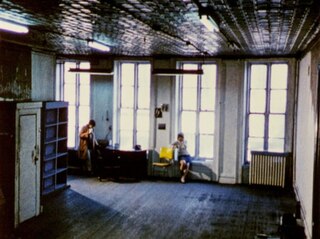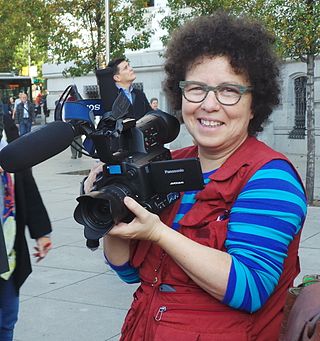Related Research Articles

A Movie is a 1958 experimental collage film by American artist Bruce Conner. It combines pieces of found footage taken from various sources such as newsreels, soft-core pornography, and B movies, all set to a score featuring Ottorino Respighi's Pines of Rome.

Dorothy Emma Arzner was an American film director whose career in Hollywood spanned from the silent era of the 1920s into the early 1940s. With the exception of long-time silent film director Lois Weber, from 1927 until her retirement from feature directing in 1943, Arzner was the only female director working in Hollywood. She was one of a very few women able to establish a successful and long career in Hollywood as a film director until the 1970s. Arzner made a total of twenty films between 1927 and 1943 and launched the careers of a number of Hollywood actresses, including Katharine Hepburn, Rosalind Russell, and Lucille Ball. Arzner was the first woman to join the Directors Guild of America and the first woman to direct a sound film.

Wavelength is a 1967 experimental film by Canadian artist Michael Snow. Shot from a fixed camera angle, it depicts a loft space with an extended zoom over the duration of the film. Considered a landmark of avant-garde cinema, it was filmed over one week in December 1966 and edited in 1967, and is an example of what film theorist P. Adams Sitney describes as "structural film", calling Snow "the dean of structural filmmakers."

Márta Mészáros is a Hungarian screenwriter and film director. The daughter of László Mészáros, a sculptor, Mészáros began her career working in documentary film, having made 25 documentary shorts over the span of ten years. Her full-length directorial debut, Eltavozott nap/The Girl (1968), was the first Hungarian film to have been directed by a woman, and won the Special Prize of the Jury at the Valladolid International Film Festival.

Canyon Cinema is an American nonprofit organization for distributing independent, avant-garde, and artist-made films. After starting in the 1960s as an exhibition program, it grew to include a nationwide newsletter and a distribution cooperative. Its exhibition activities were split off to form the San Francisco Cinematheque.

Nathaniel Dorsky is an American experimental filmmaker and film editor. His film career began during the New American Cinema movement of the 1960s, when he met his partner Jerome Hiler. He won an Emmy Award in 1967 for his work on the film Gauguin in Tahiti: Search for Paradise.
William Luhr is an American film author and professor and the author of such works as Thinking About Movies: Watching, Questioning, Enjoying,World Cinema Since 1945: An Encyclopedic History and Returning to the Scene. He is also currently a professor of English at Saint Peter's College in Jersey City, New Jersey.

Linda Williams is an American professor of film studies in the departments of Film Studies and Rhetoric at University of California, Berkeley.
Cosmic Ray is a 1962 American experimental short film directed by Bruce Conner. With both found footage and original material, it features images of countdown leader, a nude woman dancing, a Mickey Mouse cartoon, and military exercises. It is soundtracked by a performance of Ray Charles's "What'd I Say" and has been recognized by some critics as one of the first music videos.
Swedish artist Gunvor Grundel Nelson was born in 1931 in Kristinehamn, Sweden, where she now resides. She has worked as an experimental filmmaker since the 1960s. Some of her most widely known works were created while she lived in the Bay Area in the mid-1960s and early 1970s, where she became well established among other artists in the avant-garde film circles of the 1960s and to the present. As of 2006, she has to her credit 20 films, five videos, and one video installation.
Robert Nelson was an American experimental film director.
Marsha Kinder is an American film scholar and Professor of Critical Studies at the University of Southern California.

Cecilia Barriga is a Chilean-Spanish film director. Her 1991 film Meeting Two Queens was shown at Montreal Women's Film and Video Festival and New York International Festival of Gay and Lesbian Film. She directed her first feature film Time's Up! in New York City. It premiered at the Donostia-San Sebastián Film Festival in 2000 as part of Zabaltegi.
Freude (Florence) Bartlett also known as Freude Solomon-Bartlett, was an American experimental film director and founder of the Serious Business Company, a San Francisco-based film sales and film distribution company known for its collection of avant-garde, animation and women's films.
Schwechater is a 1958 experimental short film by Austrian filmmaker Peter Kubelka. It is the second entry in his trilogy of metrical films, between Adebar and Arnulf Rainer.
The End is a 1953 American short film directed by Christopher Maclaine. It tells the stories of six people on the last day of their lives. It premiered at the San Francisco Museum of Modern Art as part of Frank Stauffacher's Art in Cinema series. Though the film met audience disapproval at its premiere, it was praised by critics as a "masterpiece" and "a great work of art".

The Great Blondino is a 1967 American experimental film directed by Robert Nelson and William T. Wiley.
Anticipation of the Night is a 1958 American avant-garde film directed by Stan Brakhage. It was a breakthrough in the development of the lyrical style Brakhage used in his later films.
Triste is a 1996 American avant-garde short film directed by Nathaniel Dorsky. It is the first in a set of "Four Cinematic Songs", which also includes Variations, Arbor Vitae, and Love's Refrain.
Sirius Remembered is a 1959 American experimental short film directed by Stan Brakhage. It captures the gradual decomposition of the corpse of Sirius, the Brakhage family's dog, over the course of several months.
References
- 1 2 Richardson, Brenda (1971). "Women, Wives, Film-Makers: An Interview with Gunvor Nelson and Dorothy Wiley". Film Quarterly . 25 (1): 35. doi:10.2307/1211465. JSTOR 1211465.
- ↑ MacDonald, Scott (1998). A Critical Cinema 3: Interviews with Independent Filmmakers . University of California Press. p. 186. ISBN 978-0-520-20943-5.
- 1 2 Gill, June M. (1977). "The Films of Gunvor Nelson". Film Quarterly . 30 (3): 29. doi:10.2307/1211771. JSTOR 1211771.
- 1 2 Lipzin, Janis Crystal (2010). "Why Didn't I Work in Granite?". In Anker, Steve; Geritz, Kathy; Seid, Steve (eds.). Radical Light: Alternative Film and Video in the San Francisco Bay Area, 1945–2000. University of California Press. p. 261. ISBN 978-0-520-24911-0.
- ↑ Holmlund, Chris (2007). "Signature, Translation and Resonance in Gunvor Nelson's Films". Framework: The Journal of Cinema and Media. 48 (2). Wayne State University Press: 155. doi:10.1353/frm.2007.0013. S2CID 191530680.
- ↑ Ahlgren, Calvin (October 16, 1983). "Onscreen Strength from Offscreen Fragility". San Francisco Chronicle . p. 31.
- 1 2 3 Rabinowitz, Paula (2000). "Medium Uncool: Women Shoot Back; Feminism, Film and 1968—A Curious Documentary". Science & Society . 65 (1): 92–96.
- ↑ Knickerbocker, Paine (September 7, 1970). "S.F. Art Museum's New Curator". San Francisco Chronicle . p. 42.
- ↑ Callenbach, Ernest (1966). "Schmeerguntz". Film Quarterly . 19 (4): 67. doi:10.2307/1210411. JSTOR 1210411.
- ↑ Giardina, Carol (2010). Freedom for Women: Forging the Women's Liberation Movement, 1953–1970. University Press of Florida. p. 197. ISBN 978-0-8130-3456-0.